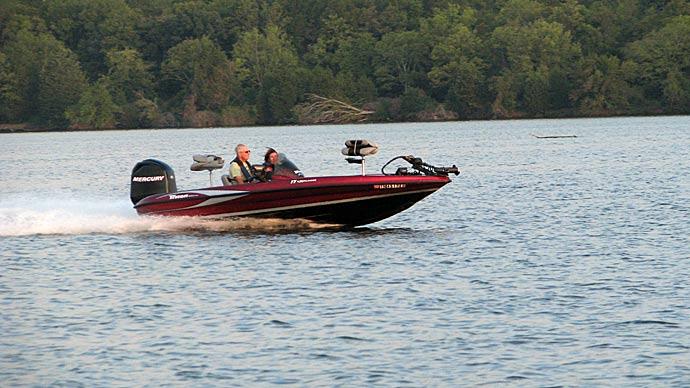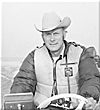
Forrest L. Wood has been described as "the real deal," "the genuine article," and "a man with unmatched ethics and character." Add to that an unsurpassed work ethic, and you have a man who turned a bass-boat company with simple beginnings into one of America's great success stories.
Ranger Boats Inc., based in Flippin, Ark., celebrates its 35th anniversary in 2003, and the tall, slender man with the signature cowboy hat said he had a straightforward formula when he founded the company in 1968.
"We just treated people right," Wood said. "An oversimplification of business success is identifying what people want, letting them know you have it, and then treating them right after the sale."

Wood is emphatic in his belief that the employees at Ranger have led to it becoming a world-renowned boat manufacturer with a reputation for unmatched quality and service. Many workers at Ranger are residents who started 10, 20, or even 30 years ago and never went away.
"We were just able to hire a lot of good ol' country folk who had the right work ethic and pride in what they were doing," Wood said. "They were good employees. Loyal employees. Men and women who were intelligent and able to figure things out."
Such are people like Randy Hopper, who started working at Ranger in high school and eventually became president of the company. Another former high school employee is Gary Howard, now director of engineering. The list of names goes on and on.
Anyone closely associated with Ranger Boats will quickly point to Wood and his wife, Nina, as the company's cornerstones whose name anglers proudly display on their boats, shirts, trucks, and just about anywhere else you can slap a Ranger logo.
In The Beginning
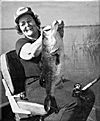
High school sweethearts Forrest and Nina forged a bond early in life that continues to this day. Both came from backgrounds of simple beginnings and lots of hard work. They applied what they learned to a business partnership that began with jobs such as raising cattle, building and bridge construction, and operating a successful fishing guide service on Bull Shoals Lake, the White River, and Crooked Creek.
That guide service eventually led Forrest and Nina into the boat-building business. While they could book several float trips during the spring and summer, things would get pretty tough in the wintertime. As Forrest describes it, they started building some plywood Jon boats to keep his good guides on the payroll during the winter. He knew of a man in town covering plywood boats with fiberglass to keep them from leaking, so Forrest thought he would talk to the gentleman and learn how to do the same thing.
"You just sanded the wood, got it real clean, catalyzed the resin, put the cloth on, saturated it, and it adhered to the wood," he said. "Fiberglass will adhere to just about anything it comes in contact with unless (that item) is waxed properly. One of the first boats we ever made, we didn't get the mold waxed very good, and it adhered to the mold, and we spent several days getting it released."
After that, it didn't take Forrest and his team long to become proficient at waxing the molds.
Forrest said they had just started making what he described as a "lake boat." But it so happened that it was the time when bass tournaments were starting up in earnest in the Southeast. He decided to attend one of the tournaments on Greers Ferry Lake to see if anyone was interested in buying boats from him.
"It was the first one I had ever gone to," Wood said. "Some friends and I went fishing the tournament, and I ended up selling a boat or two." One of those boats he sold was to Bill Dance, who went on to become a legend on the pro-fishing circuit.
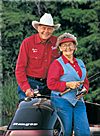
In 1968, Forrest and Nina Wood began Ranger Boats. Forrest had chosen Ranger because he felt it was a good, firm name, just like the Texas Rangers and the Army Rangers. The first six boats were built in what is now the local firehouse in downtown Flippin. Manufacturing was then moved to an unoccupied dance hall on the edge of town known as the Silver Star. In 1970, Ranger manufactured 1,200 boats that sold for $1,000 each, complete with lights and steering. Demand was high, and orders were streaming in.
On May 4, 1971, one of the most infamous fires in Flippin's history burned down the Ranger Boats factory. A static spark of electricity or electrical shock ignited acetone, and the fire quickly spread throughout the building. Forrest and a friend could get inside the building and salvage 60 boat orders from inside a metal desk.
What happened next has become part of the Ranger legend. Bound and determined to keep his 60 employees on the payroll, Forrest nailed a phone to a tree near the plant's ruins and began to conduct business while friends helped clean up the rubble. With a lot of determination and perseverance from all the employees, they were building boats again precisely 40 days and nights after the disaster struck. Those 60 orders would be filled.
Even though there were a lot of hurdles to cross, including a tornado and growing debt, business began to flourish for Ranger Boats in the early to mid-1970s. Not by coincidence, that was the same time Wood began fishing the fast-growing Bass Anglers Sportsman Society (BASS) tournament circuit. Even though he was a good angler, qualifying for the Bassmasters Classic in 1971 and 1979, he was there to display and sell boats.
"The pros liked our boats because we custom-built them," Wood said. "We would build the inside configuration however somebody wanted it. We were fishermen, and we understood what people wanted."
Many pro anglers would sit down with Forrest and draw the design of the boat they wanted on the nearest piece of paper. He would often go back to the factory with a sketch on a napkin in one hand and an order in the other. His employees knew what to do after that.
"We wanted to make the best possible product," Wood said. "We weren't interested in making something that anyone would buy. We were interested in the top of the market. You get that by making a quality product."
About The Boats
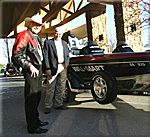
"I vividly remember riding in my first Ranger boat. We put an engine on it and took it to the lake. It was quite an experience for me, and I never forgot it. Sitting in a boat, watching it hit the waves and feeling vibrations - you get a real feel for the boat, and there is no substitute for that."
Randy Hopper,
President, Ranger Boats
Hopper has been passionate about building a better boat since he began working for Ranger more than 30 years ago. He was still in high school when he began work there and remembers being handed a broom the first night of work. Moving from spraying gel coat to working the chopper gun to supervising the night shift, Hopper eventually became president of Ranger Boats in 1989.
He and several longtime employees and a dedicated founder created and implemented some of the most innovative ideas ever integrated into a bass boat. Ranger Boats has been credited with structural designs and performance enhancements that revolutionized the fishing-boat industry.
"We just took some simple ideas and incorporated them into a highly specialized fishing machine," Hopper said. "People liked what they saw and wanted the boats. People lined up for the boats because they were getting something very functional for them, giving them value."
In the early '70s, most bass boats were narrow and straight, with a flat bottom. But the design engineers at Ranger figured out that a V-shaped hull and broader beam would provide a much better ride and much more room for fishermen to move around inside the boats. As the overall design of the boats changed, so did the size. The boats got bigger and bigger.
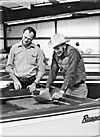
"I think in the early stages of the bass boat, the horsepower offered on most engines couldn't push around our fishing boats," Howard said. "But as time progressed, they made larger horsepower engines, and the boats got bigger as well."
As the engines got bigger, stronger transoms became essential. The early transoms were made of plywood and were subject to rot after constant exposure to water. Even the transoms that were covered with fiberglass tended to leak.
"We just needed something to prevent the rotting and water saturations," Howard said. "Especially if somebody hung an engine on the boat and didn't seal it properly, water would get in there, and the transom would get mushy and weak. Everybody knew there had to be a better way."
It was Hopper who found that way. He heard about a process using fiberglass called pultrusion that resulted in a solid, very consistent material.
"I had an engineering friend with whom we had done some projects unrelated to the marine industry, and he was very aware of the potential that existed with pultrusion," Hopper said. "With the testing that had been done independently and on our own, we saw the strength characteristics of pultrusion and the ability to engineer a product that was the same every time. I thought we needed to build our transoms out of this material."
Hopper began experimenting with the process (which he describes as "like trying to stuff an oyster into a parking meter") in 1985. In 1986 he was able to secure a patent on the process related to building transoms, and in 1987 Ranger introduced their first models with pultruded fiberglass transoms. The 2003 Ranger models still feature this innovative design that has stood the test of time.
The pultruded fiberglass transom is just one example of the many innovative and creative designs Ranger has introduced through the years that have significantly improved their fishing boats' durability, feel performance and overall quality.
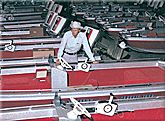
Innovations such as the revolutionary molded fiberglass stringer system, molding the liner of the boat interior in one piece and gluing the consoles in afterward, creating a VS engine setback design to provide better engine performance; a power distributing transom with integral fiberglass gussets and flotation tanks, and a fluid-driven steering system that has made cable steering almost obsolete are Ranger hallmarks.
One of the critical concepts Ranger has kept in the design of its boats through the years is what has been termed a "one-piece feel." This has been achieved by using foam as the primary flotation material and inserting it into almost every cavity of the boat. The foam is a solid and rigid material but very lightweight.
"The deck and hull are permanently foamed together to create that one-piece feel," Hopper said. "It's unlike most competitors, where you could take the deck off the boats. Once ours is together, it stays that way. The advantage of that is when you are crossing waves on a lake, you don't have that resonant sound like a bass drum that comes from two independent parts. It's a boat that moves together all in one piece."
It's About Fishing
When Forrest Wood fished his first bass tournament, Ranger Boats was all about fishing. With the boater's safety in mind, Ranger led the way to new U.S. Coast Guard Flotation Standards in 1972. In 1973, Forrest's aerated livewell was patented and eventually became standard on Ranger boats.
Another Ranger hallmark is attention to detail, including early additions like carpeting and running rod racks. Over the years, the decks of the boats have been raised and widened to provide more room and to allow for the extended use of specific fishing techniques. Unique designs have also been developed to better accommodate fishing equipment like depth finders and trolling motors. The heavy-duty 6-gauge trolling motor wire was also added to increase efficiency.
Improvements to livewells have occurred, such as the venturi livewell aeration system. Storage compartments have been reinforced for added strength. And most recently, Ranger introduced STS high-performance seats that provide more comfort. The list seems endless.
A key reason Ranger has been in tune with the needs of fishermen is that so many of the company's employees fish themselves. "A lot of our employees fish local tournaments," Hopper said. "We have one guy who is a supervisor that is a former All-American champion."
According to Howard: "Our employees like the products, they know the boats, and they care about them. I think that makes a big difference."
Of course, Ranger has never stopped listening to its employees, its pros, and, most of all, its customers. "I think you listen as much as you ask, and I think you try to stay ahead of the curve," Hopper said. "That has been a big part of our success."
Forrest Wood now spends more time working cattle than actually building boats, but he remains an icon in the fishing industry, as evidenced by the tournament series that bears his name (the Wal-Mart FLW Tour). Forrest, however, is always quick to point out that his true love, Nina, has been the best, most dedicated angler in the family.
"She just dearly loves fishing, and she has done it all her life," he said. "She has a real passion for it."
But can she outfish him? "Absolutely," he said.
Content provided by Bass Fishing Magazine, the official publication of FLW Outdoors
Editor's Note: Surrounded by his loving family, Forrest L. Wood, 87, of Flippin, Arkansas, passed peacefully into eternity on January 25, 2020.


